Development of an Automated Employee Performance System Project
VerifiedAdded on 2021/06/05
|41
|9932
|112
Project
AI Summary
This project focuses on the design and implementation of an automated requirement gathering and employee performance management system. The system aims to improve the efficiency and accuracy of employee evaluations, replacing manual methods with a web-based solution. The project incorporates several key components, including a survey system for gathering feedback, an algorithm for processing evaluation questions, and a predictive algorithm for generating requirements for vacant positions. The system utilizes HTML forms for questionnaires, PHP for result processing, and a MYSQL database for data storage. The scope of the project is the design, implementation, and testing of the web-based employee performance management system, with a focus on security and accurate performance assessment. The project's significance lies in its potential to enhance the Human Resource department's ability to evaluate employees, select suitable candidates, and align employee performance with company goals. The limitations include a lack of specific office-related survey questions and the system's inability to perform performance appraisal duties. The expected result is a system that streamlines employee performance evaluation and generates requirements for optimal performance. The project is structured into five chapters, covering background, literature review, methodology, design and implementation, and conclusion. The system is expected to help Human Resource departments in their tasks and also assist management in setting goals and rewarding employees.
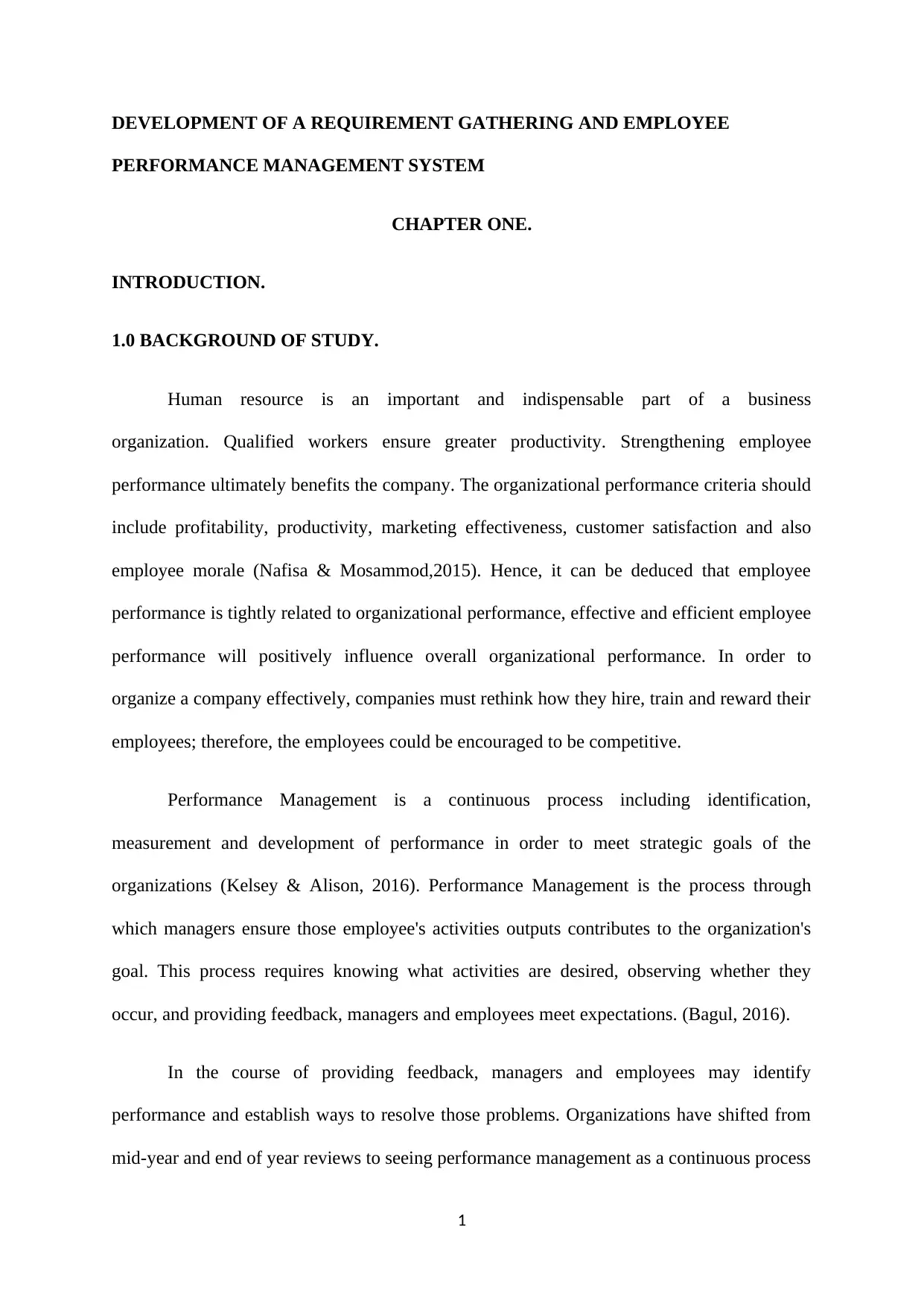
DEVELOPMENT OF A REQUIREMENT GATHERING AND EMPLOYEE
PERFORMANCE MANAGEMENT SYSTEM
CHAPTER ONE.
INTRODUCTION.
1.0 BACKGROUND OF STUDY.
Human resource is an important and indispensable part of a business
organization. Qualified workers ensure greater productivity. Strengthening employee
performance ultimately benefits the company. The organizational performance criteria should
include profitability, productivity, marketing effectiveness, customer satisfaction and also
employee morale (Nafisa & Mosammod,2015). Hence, it can be deduced that employee
performance is tightly related to organizational performance, effective and efficient employee
performance will positively influence overall organizational performance. In order to
organize a company effectively, companies must rethink how they hire, train and reward their
employees; therefore, the employees could be encouraged to be competitive.
Performance Management is a continuous process including identification,
measurement and development of performance in order to meet strategic goals of the
organizations (Kelsey & Alison, 2016). Performance Management is the process through
which managers ensure those employee's activities outputs contributes to the organization's
goal. This process requires knowing what activities are desired, observing whether they
occur, and providing feedback, managers and employees meet expectations. (Bagul, 2016).
In the course of providing feedback, managers and employees may identify
performance and establish ways to resolve those problems. Organizations have shifted from
mid-year and end of year reviews to seeing performance management as a continuous process
1
PERFORMANCE MANAGEMENT SYSTEM
CHAPTER ONE.
INTRODUCTION.
1.0 BACKGROUND OF STUDY.
Human resource is an important and indispensable part of a business
organization. Qualified workers ensure greater productivity. Strengthening employee
performance ultimately benefits the company. The organizational performance criteria should
include profitability, productivity, marketing effectiveness, customer satisfaction and also
employee morale (Nafisa & Mosammod,2015). Hence, it can be deduced that employee
performance is tightly related to organizational performance, effective and efficient employee
performance will positively influence overall organizational performance. In order to
organize a company effectively, companies must rethink how they hire, train and reward their
employees; therefore, the employees could be encouraged to be competitive.
Performance Management is a continuous process including identification,
measurement and development of performance in order to meet strategic goals of the
organizations (Kelsey & Alison, 2016). Performance Management is the process through
which managers ensure those employee's activities outputs contributes to the organization's
goal. This process requires knowing what activities are desired, observing whether they
occur, and providing feedback, managers and employees meet expectations. (Bagul, 2016).
In the course of providing feedback, managers and employees may identify
performance and establish ways to resolve those problems. Organizations have shifted from
mid-year and end of year reviews to seeing performance management as a continuous process
1
Paraphrase This Document
Need a fresh take? Get an instant paraphrase of this document with our AI Paraphraser

in which just one part which is the implementation of discrete, formal performance feedback
sessions (London & Smither, 2002).
Organizations are seeking to develop, motivate and increase the performance of their
employees in a variety of human resources applications and training. Thus, performance
management should be an important step in the organization's HRM system and influences
employee performance and then to organizational performance. Efficacy of a Performance
management system depends solely on the strengths of design and implementation methods.
A system lacking in appropriateness (of design, implementation, documentation, or user
accountability) will not only fail to improve employee performance but may actually harm
the organization. Poor system implementation can result in legal ramifications, undesirable
employee perceptions and behaviours (e.g., burnout, job dissatisfaction, turnover), and lost
opportunities for enhancing productivity (Aguinis, 2009).
Performance Management leads to Performance Appraisal which is an important tool
that can be used to manage performance management as Performance Appraisal is usually
carried out by line Managers and not Human Resource Professionals, it is important to
understand the role of Performance Appraisal and how it contributes to employee
performance. Performance Appraisal is shown in Figure 1.0 below. Through the aid of
performance management system by the Human Resource Professionals, a Performance
appraisal can be carried out by managers who will identify good and bad performers.
Performance appraisal is the process of obtaining, analysis and record in information about
the relative worth of an employee. The focus of the performance appraisal is measuring and
improving the actual performance of an employee and also the future potential of the
employee. Its aim is to measure what an employee does. (Bagul, 2016).
2
sessions (London & Smither, 2002).
Organizations are seeking to develop, motivate and increase the performance of their
employees in a variety of human resources applications and training. Thus, performance
management should be an important step in the organization's HRM system and influences
employee performance and then to organizational performance. Efficacy of a Performance
management system depends solely on the strengths of design and implementation methods.
A system lacking in appropriateness (of design, implementation, documentation, or user
accountability) will not only fail to improve employee performance but may actually harm
the organization. Poor system implementation can result in legal ramifications, undesirable
employee perceptions and behaviours (e.g., burnout, job dissatisfaction, turnover), and lost
opportunities for enhancing productivity (Aguinis, 2009).
Performance Management leads to Performance Appraisal which is an important tool
that can be used to manage performance management as Performance Appraisal is usually
carried out by line Managers and not Human Resource Professionals, it is important to
understand the role of Performance Appraisal and how it contributes to employee
performance. Performance Appraisal is shown in Figure 1.0 below. Through the aid of
performance management system by the Human Resource Professionals, a Performance
appraisal can be carried out by managers who will identify good and bad performers.
Performance appraisal is the process of obtaining, analysis and record in information about
the relative worth of an employee. The focus of the performance appraisal is measuring and
improving the actual performance of an employee and also the future potential of the
employee. Its aim is to measure what an employee does. (Bagul, 2016).
2

FIG 1.0: A manager appraising his employees.
Of further note, employees today are increasingly likely to follow self-guided career paths not
organizationally bound career paths. As allegiance to the organization becomes less of a
deciding factor in whether an employee stays or leaves to work for a competitor, companies
must increase efforts to retain talent. Effective Performance Management increases employee
perceptions of opportunities and support for advancement within the company (Ready, Hill,
& Conger, 2008). Thus, in addition to providing a competitive advantage in market
performance, effectively designed and implemented Performance Management systems can
offer organizations competitive advantages in terms of attracting and retaining top industry
talent.
3
Of further note, employees today are increasingly likely to follow self-guided career paths not
organizationally bound career paths. As allegiance to the organization becomes less of a
deciding factor in whether an employee stays or leaves to work for a competitor, companies
must increase efforts to retain talent. Effective Performance Management increases employee
perceptions of opportunities and support for advancement within the company (Ready, Hill,
& Conger, 2008). Thus, in addition to providing a competitive advantage in market
performance, effectively designed and implemented Performance Management systems can
offer organizations competitive advantages in terms of attracting and retaining top industry
talent.
3
⊘ This is a preview!⊘
Do you want full access?
Subscribe today to unlock all pages.

Trusted by 1+ million students worldwide
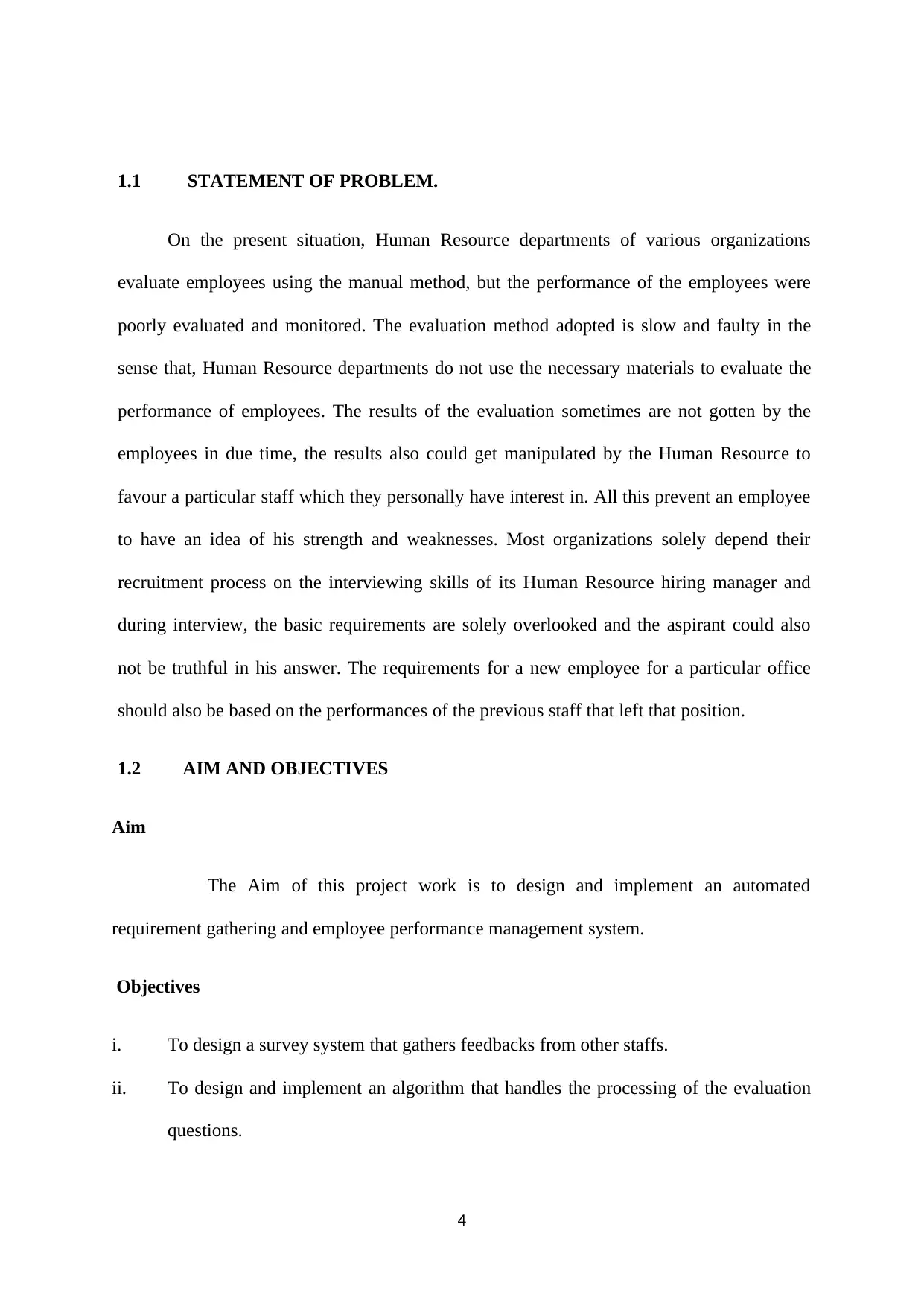
1.1 STATEMENT OF PROBLEM.
On the present situation, Human Resource departments of various organizations
evaluate employees using the manual method, but the performance of the employees were
poorly evaluated and monitored. The evaluation method adopted is slow and faulty in the
sense that, Human Resource departments do not use the necessary materials to evaluate the
performance of employees. The results of the evaluation sometimes are not gotten by the
employees in due time, the results also could get manipulated by the Human Resource to
favour a particular staff which they personally have interest in. All this prevent an employee
to have an idea of his strength and weaknesses. Most organizations solely depend their
recruitment process on the interviewing skills of its Human Resource hiring manager and
during interview, the basic requirements are solely overlooked and the aspirant could also
not be truthful in his answer. The requirements for a new employee for a particular office
should also be based on the performances of the previous staff that left that position.
1.2 AIM AND OBJECTIVES
Aim
The Aim of this project work is to design and implement an automated
requirement gathering and employee performance management system.
Objectives
i. To design a survey system that gathers feedbacks from other staffs.
ii. To design and implement an algorithm that handles the processing of the evaluation
questions.
4
On the present situation, Human Resource departments of various organizations
evaluate employees using the manual method, but the performance of the employees were
poorly evaluated and monitored. The evaluation method adopted is slow and faulty in the
sense that, Human Resource departments do not use the necessary materials to evaluate the
performance of employees. The results of the evaluation sometimes are not gotten by the
employees in due time, the results also could get manipulated by the Human Resource to
favour a particular staff which they personally have interest in. All this prevent an employee
to have an idea of his strength and weaknesses. Most organizations solely depend their
recruitment process on the interviewing skills of its Human Resource hiring manager and
during interview, the basic requirements are solely overlooked and the aspirant could also
not be truthful in his answer. The requirements for a new employee for a particular office
should also be based on the performances of the previous staff that left that position.
1.2 AIM AND OBJECTIVES
Aim
The Aim of this project work is to design and implement an automated
requirement gathering and employee performance management system.
Objectives
i. To design a survey system that gathers feedbacks from other staffs.
ii. To design and implement an algorithm that handles the processing of the evaluation
questions.
4
Paraphrase This Document
Need a fresh take? Get an instant paraphrase of this document with our AI Paraphraser

iii. To implement a predictive algorithm that generates requirements for vacant office
positions.
1.3 METHODOLOGY.
The HR i.e. Human Resource department generates requirements which is stored in
the database(MYSQL) for applicants and from there they employ a staff whose details are
stored in database, after a period of time they pass across evaluation questions which they
have prepared to other staffs who will then perform evaluation on a particular staff under
review, which then results are gotten and new and additional requirements are generated due
to the performance of the staff. After which performance documentation is performed the
results are gotten and stored in the database, the result is also passed to the management and
the management perform the appraisal depending on the performance of the staff.
The performance evaluation questions will be in form of a questionnaire handled with HTML
forms and then sent to the database(MYSQL), the evaluation of the results will be handled by
PHP.
1.4 SCOPE OF STUDY.
This project work will basically focus on the design, implementation and testing of
the web-based employee performance management system. The system will prioritize
security of authorized personnel to prevent unauthorized access and also deduce accurate
summation of performing employees and non-performers. It will also automatically generate
new requirements for the office when an employee is leaving based on his strength and
weaknesses, the new requirements will try and ensure optimal performance of the next
employee.
5
positions.
1.3 METHODOLOGY.
The HR i.e. Human Resource department generates requirements which is stored in
the database(MYSQL) for applicants and from there they employ a staff whose details are
stored in database, after a period of time they pass across evaluation questions which they
have prepared to other staffs who will then perform evaluation on a particular staff under
review, which then results are gotten and new and additional requirements are generated due
to the performance of the staff. After which performance documentation is performed the
results are gotten and stored in the database, the result is also passed to the management and
the management perform the appraisal depending on the performance of the staff.
The performance evaluation questions will be in form of a questionnaire handled with HTML
forms and then sent to the database(MYSQL), the evaluation of the results will be handled by
PHP.
1.4 SCOPE OF STUDY.
This project work will basically focus on the design, implementation and testing of
the web-based employee performance management system. The system will prioritize
security of authorized personnel to prevent unauthorized access and also deduce accurate
summation of performing employees and non-performers. It will also automatically generate
new requirements for the office when an employee is leaving based on his strength and
weaknesses, the new requirements will try and ensure optimal performance of the next
employee.
5
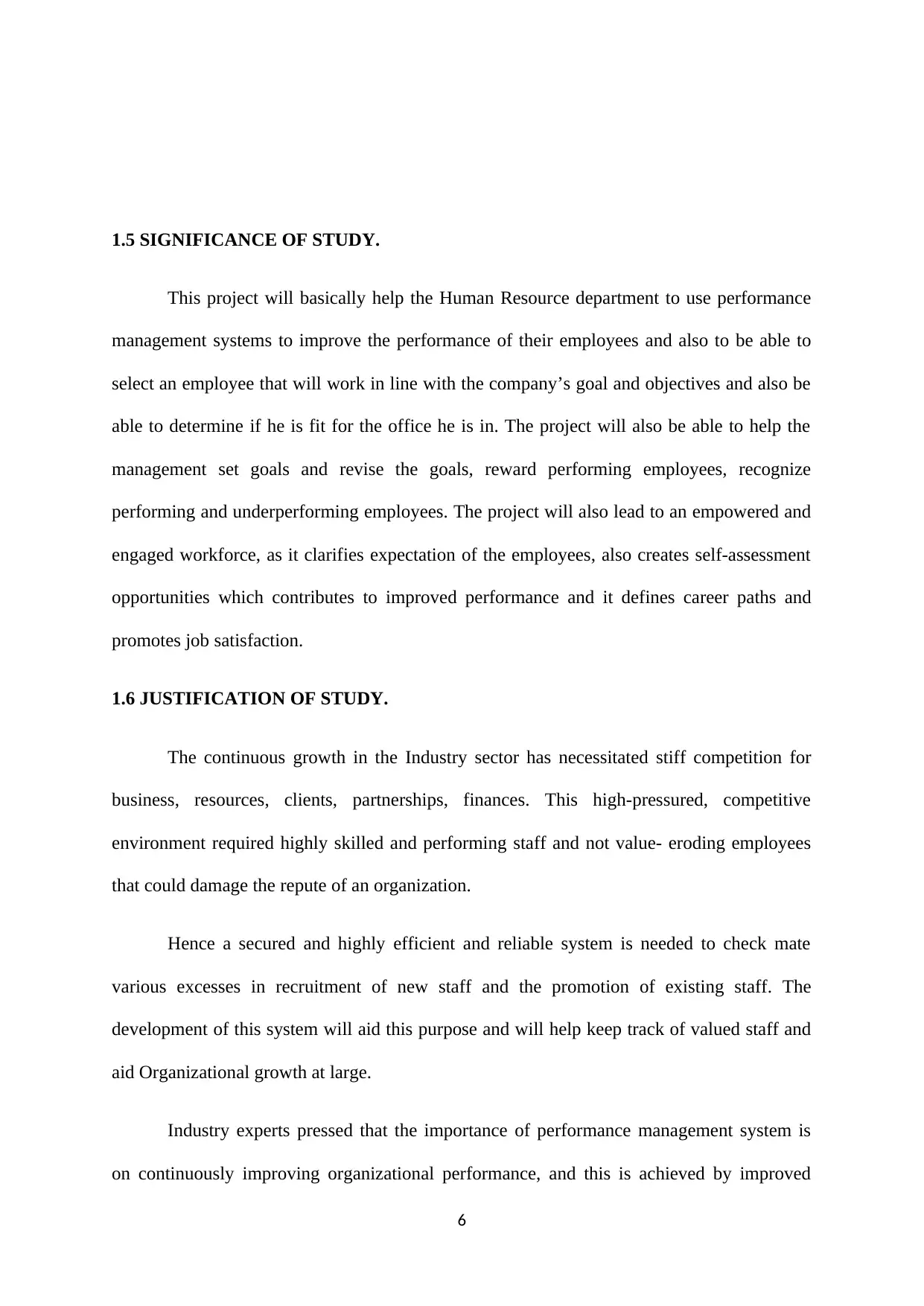
1.5 SIGNIFICANCE OF STUDY.
This project will basically help the Human Resource department to use performance
management systems to improve the performance of their employees and also to be able to
select an employee that will work in line with the company’s goal and objectives and also be
able to determine if he is fit for the office he is in. The project will also be able to help the
management set goals and revise the goals, reward performing employees, recognize
performing and underperforming employees. The project will also lead to an empowered and
engaged workforce, as it clarifies expectation of the employees, also creates self-assessment
opportunities which contributes to improved performance and it defines career paths and
promotes job satisfaction.
1.6 JUSTIFICATION OF STUDY.
The continuous growth in the Industry sector has necessitated stiff competition for
business, resources, clients, partnerships, finances. This high-pressured, competitive
environment required highly skilled and performing staff and not value- eroding employees
that could damage the repute of an organization.
Hence a secured and highly efficient and reliable system is needed to check mate
various excesses in recruitment of new staff and the promotion of existing staff. The
development of this system will aid this purpose and will help keep track of valued staff and
aid Organizational growth at large.
Industry experts pressed that the importance of performance management system is
on continuously improving organizational performance, and this is achieved by improved
6
This project will basically help the Human Resource department to use performance
management systems to improve the performance of their employees and also to be able to
select an employee that will work in line with the company’s goal and objectives and also be
able to determine if he is fit for the office he is in. The project will also be able to help the
management set goals and revise the goals, reward performing employees, recognize
performing and underperforming employees. The project will also lead to an empowered and
engaged workforce, as it clarifies expectation of the employees, also creates self-assessment
opportunities which contributes to improved performance and it defines career paths and
promotes job satisfaction.
1.6 JUSTIFICATION OF STUDY.
The continuous growth in the Industry sector has necessitated stiff competition for
business, resources, clients, partnerships, finances. This high-pressured, competitive
environment required highly skilled and performing staff and not value- eroding employees
that could damage the repute of an organization.
Hence a secured and highly efficient and reliable system is needed to check mate
various excesses in recruitment of new staff and the promotion of existing staff. The
development of this system will aid this purpose and will help keep track of valued staff and
aid Organizational growth at large.
Industry experts pressed that the importance of performance management system is
on continuously improving organizational performance, and this is achieved by improved
6
⊘ This is a preview!⊘
Do you want full access?
Subscribe today to unlock all pages.

Trusted by 1+ million students worldwide
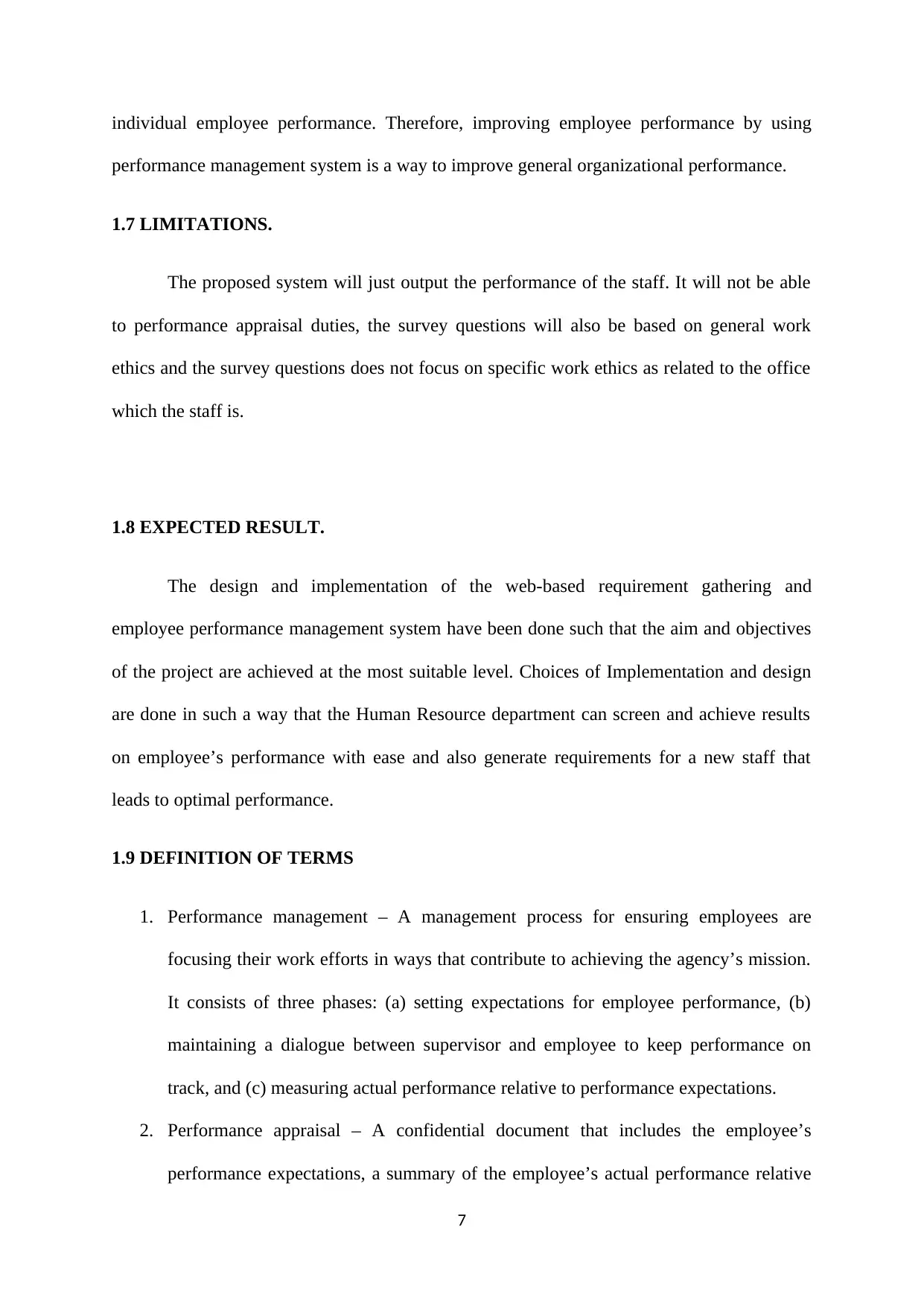
individual employee performance. Therefore, improving employee performance by using
performance management system is a way to improve general organizational performance.
1.7 LIMITATIONS.
The proposed system will just output the performance of the staff. It will not be able
to performance appraisal duties, the survey questions will also be based on general work
ethics and the survey questions does not focus on specific work ethics as related to the office
which the staff is.
1.8 EXPECTED RESULT.
The design and implementation of the web-based requirement gathering and
employee performance management system have been done such that the aim and objectives
of the project are achieved at the most suitable level. Choices of Implementation and design
are done in such a way that the Human Resource department can screen and achieve results
on employee’s performance with ease and also generate requirements for a new staff that
leads to optimal performance.
1.9 DEFINITION OF TERMS
1. Performance management – A management process for ensuring employees are
focusing their work efforts in ways that contribute to achieving the agency’s mission.
It consists of three phases: (a) setting expectations for employee performance, (b)
maintaining a dialogue between supervisor and employee to keep performance on
track, and (c) measuring actual performance relative to performance expectations.
2. Performance appraisal – A confidential document that includes the employee’s
performance expectations, a summary of the employee’s actual performance relative
7
performance management system is a way to improve general organizational performance.
1.7 LIMITATIONS.
The proposed system will just output the performance of the staff. It will not be able
to performance appraisal duties, the survey questions will also be based on general work
ethics and the survey questions does not focus on specific work ethics as related to the office
which the staff is.
1.8 EXPECTED RESULT.
The design and implementation of the web-based requirement gathering and
employee performance management system have been done such that the aim and objectives
of the project are achieved at the most suitable level. Choices of Implementation and design
are done in such a way that the Human Resource department can screen and achieve results
on employee’s performance with ease and also generate requirements for a new staff that
leads to optimal performance.
1.9 DEFINITION OF TERMS
1. Performance management – A management process for ensuring employees are
focusing their work efforts in ways that contribute to achieving the agency’s mission.
It consists of three phases: (a) setting expectations for employee performance, (b)
maintaining a dialogue between supervisor and employee to keep performance on
track, and (c) measuring actual performance relative to performance expectations.
2. Performance appraisal – A confidential document that includes the employee’s
performance expectations, a summary of the employee’s actual performance relative
7
Paraphrase This Document
Need a fresh take? Get an instant paraphrase of this document with our AI Paraphraser
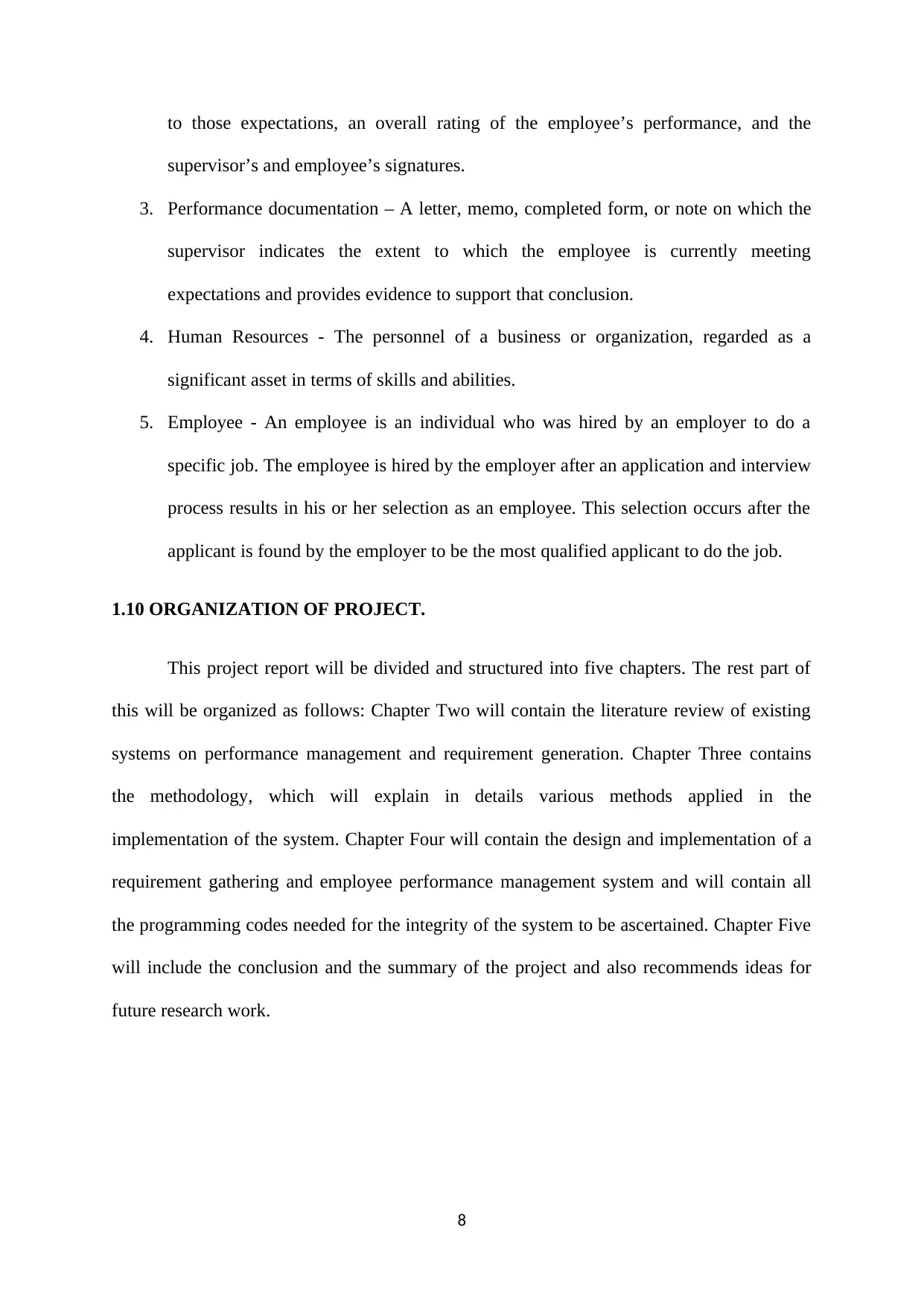
to those expectations, an overall rating of the employee’s performance, and the
supervisor’s and employee’s signatures.
3. Performance documentation – A letter, memo, completed form, or note on which the
supervisor indicates the extent to which the employee is currently meeting
expectations and provides evidence to support that conclusion.
4. Human Resources - The personnel of a business or organization, regarded as a
significant asset in terms of skills and abilities.
5. Employee - An employee is an individual who was hired by an employer to do a
specific job. The employee is hired by the employer after an application and interview
process results in his or her selection as an employee. This selection occurs after the
applicant is found by the employer to be the most qualified applicant to do the job.
1.10 ORGANIZATION OF PROJECT.
This project report will be divided and structured into five chapters. The rest part of
this will be organized as follows: Chapter Two will contain the literature review of existing
systems on performance management and requirement generation. Chapter Three contains
the methodology, which will explain in details various methods applied in the
implementation of the system. Chapter Four will contain the design and implementation of a
requirement gathering and employee performance management system and will contain all
the programming codes needed for the integrity of the system to be ascertained. Chapter Five
will include the conclusion and the summary of the project and also recommends ideas for
future research work.
8
supervisor’s and employee’s signatures.
3. Performance documentation – A letter, memo, completed form, or note on which the
supervisor indicates the extent to which the employee is currently meeting
expectations and provides evidence to support that conclusion.
4. Human Resources - The personnel of a business or organization, regarded as a
significant asset in terms of skills and abilities.
5. Employee - An employee is an individual who was hired by an employer to do a
specific job. The employee is hired by the employer after an application and interview
process results in his or her selection as an employee. This selection occurs after the
applicant is found by the employer to be the most qualified applicant to do the job.
1.10 ORGANIZATION OF PROJECT.
This project report will be divided and structured into five chapters. The rest part of
this will be organized as follows: Chapter Two will contain the literature review of existing
systems on performance management and requirement generation. Chapter Three contains
the methodology, which will explain in details various methods applied in the
implementation of the system. Chapter Four will contain the design and implementation of a
requirement gathering and employee performance management system and will contain all
the programming codes needed for the integrity of the system to be ascertained. Chapter Five
will include the conclusion and the summary of the project and also recommends ideas for
future research work.
8

CHAPTER TWO
LITERATURE REVIEW.
INTRODUCTION
There are many definitions of Performance Management. However, in principle it is
defined as a process of measuring and developing the individual and the team performance; a
set of Performance Management practices with goal setting and planning, monitoring and
feedback, appraising and remunerating of employees (Aguinis and Pierce 2007, De Andres et
al. 2010).
Some scientists have taken an even broader approach, incorporating topics like
managing by values, empowerment and participative management (Mone et al. 2011, Biron
et al. 2011), or organisational performance and leadership (Kivipõld and Vadi 2013), or have
associated it with creating a shared vision of the aims of the organisation (Decramer 2013), or
emphasise the need to give equal prominence to leadership and management to achieve their
objectives in schools and colleges (Bush and Middlewood 2013). Performance Management
is also an integral part of the managerial control system aimed at employee work activities
and work results. It has developed into an exchange system of work-related information,
where both employer and employee express their wishes and ideas towards creating mutually
beneficial relationships. Special emphasis is on informal communication, which assumes a
development of corresponding organisational culture (Miah and Hossan 2012).
The latest academic literature on Performance Management has moved from the
employee Performance Appraisal to a variety of HRM activities, where the importance of
employee development and self-assessment are emphasised, which requires the creation of a
suitable work environment (Decramer 2013, Gravina and Siers 2011, Edler et al. 2012,
Haines and St-Onge 2012, Soss et al. 2011). Modern approaches of Performance
Management enable open and collective leadership and allow administrative control to be
9
LITERATURE REVIEW.
INTRODUCTION
There are many definitions of Performance Management. However, in principle it is
defined as a process of measuring and developing the individual and the team performance; a
set of Performance Management practices with goal setting and planning, monitoring and
feedback, appraising and remunerating of employees (Aguinis and Pierce 2007, De Andres et
al. 2010).
Some scientists have taken an even broader approach, incorporating topics like
managing by values, empowerment and participative management (Mone et al. 2011, Biron
et al. 2011), or organisational performance and leadership (Kivipõld and Vadi 2013), or have
associated it with creating a shared vision of the aims of the organisation (Decramer 2013), or
emphasise the need to give equal prominence to leadership and management to achieve their
objectives in schools and colleges (Bush and Middlewood 2013). Performance Management
is also an integral part of the managerial control system aimed at employee work activities
and work results. It has developed into an exchange system of work-related information,
where both employer and employee express their wishes and ideas towards creating mutually
beneficial relationships. Special emphasis is on informal communication, which assumes a
development of corresponding organisational culture (Miah and Hossan 2012).
The latest academic literature on Performance Management has moved from the
employee Performance Appraisal to a variety of HRM activities, where the importance of
employee development and self-assessment are emphasised, which requires the creation of a
suitable work environment (Decramer 2013, Gravina and Siers 2011, Edler et al. 2012,
Haines and St-Onge 2012, Soss et al. 2011). Modern approaches of Performance
Management enable open and collective leadership and allow administrative control to be
9
⊘ This is a preview!⊘
Do you want full access?
Subscribe today to unlock all pages.

Trusted by 1+ million students worldwide
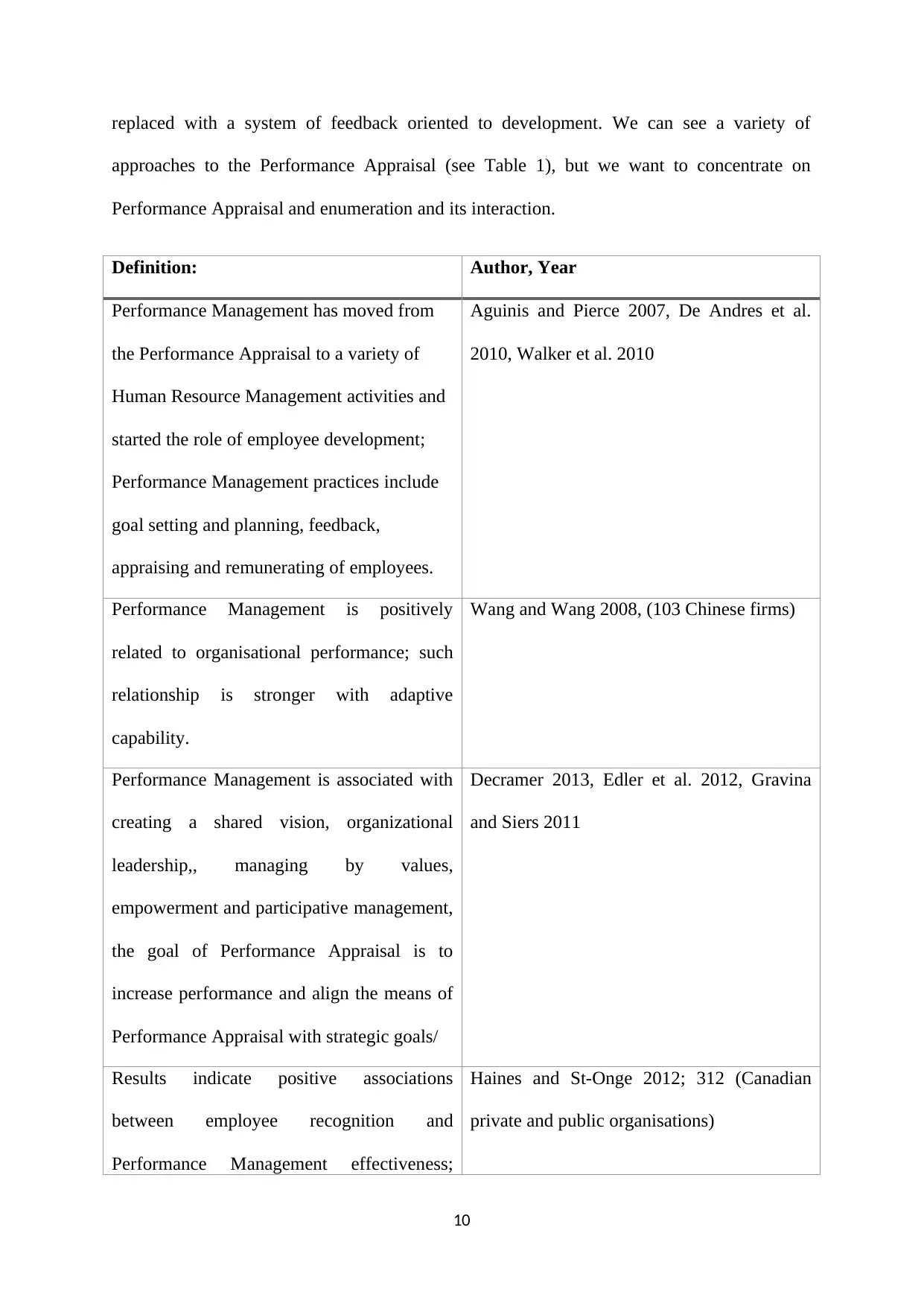
replaced with a system of feedback oriented to development. We can see a variety of
approaches to the Performance Appraisal (see Table 1), but we want to concentrate on
Performance Appraisal and enumeration and its interaction.
Definition: Author, Year
Performance Management has moved from
the Performance Appraisal to a variety of
Human Resource Management activities and
started the role of employee development;
Performance Management practices include
goal setting and planning, feedback,
appraising and remunerating of employees.
Aguinis and Pierce 2007, De Andres et al.
2010, Walker et al. 2010
Performance Management is positively
related to organisational performance; such
relationship is stronger with adaptive
capability.
Wang and Wang 2008, (103 Chinese firms)
Performance Management is associated with
creating a shared vision, organizational
leadership,, managing by values,
empowerment and participative management,
the goal of Performance Appraisal is to
increase performance and align the means of
Performance Appraisal with strategic goals/
Decramer 2013, Edler et al. 2012, Gravina
and Siers 2011
Results indicate positive associations
between employee recognition and
Performance Management effectiveness;
Haines and St-Onge 2012; 312 (Canadian
private and public organisations)
10
approaches to the Performance Appraisal (see Table 1), but we want to concentrate on
Performance Appraisal and enumeration and its interaction.
Definition: Author, Year
Performance Management has moved from
the Performance Appraisal to a variety of
Human Resource Management activities and
started the role of employee development;
Performance Management practices include
goal setting and planning, feedback,
appraising and remunerating of employees.
Aguinis and Pierce 2007, De Andres et al.
2010, Walker et al. 2010
Performance Management is positively
related to organisational performance; such
relationship is stronger with adaptive
capability.
Wang and Wang 2008, (103 Chinese firms)
Performance Management is associated with
creating a shared vision, organizational
leadership,, managing by values,
empowerment and participative management,
the goal of Performance Appraisal is to
increase performance and align the means of
Performance Appraisal with strategic goals/
Decramer 2013, Edler et al. 2012, Gravina
and Siers 2011
Results indicate positive associations
between employee recognition and
Performance Management effectiveness;
Haines and St-Onge 2012; 312 (Canadian
private and public organisations)
10
Paraphrase This Document
Need a fresh take? Get an instant paraphrase of this document with our AI Paraphraser
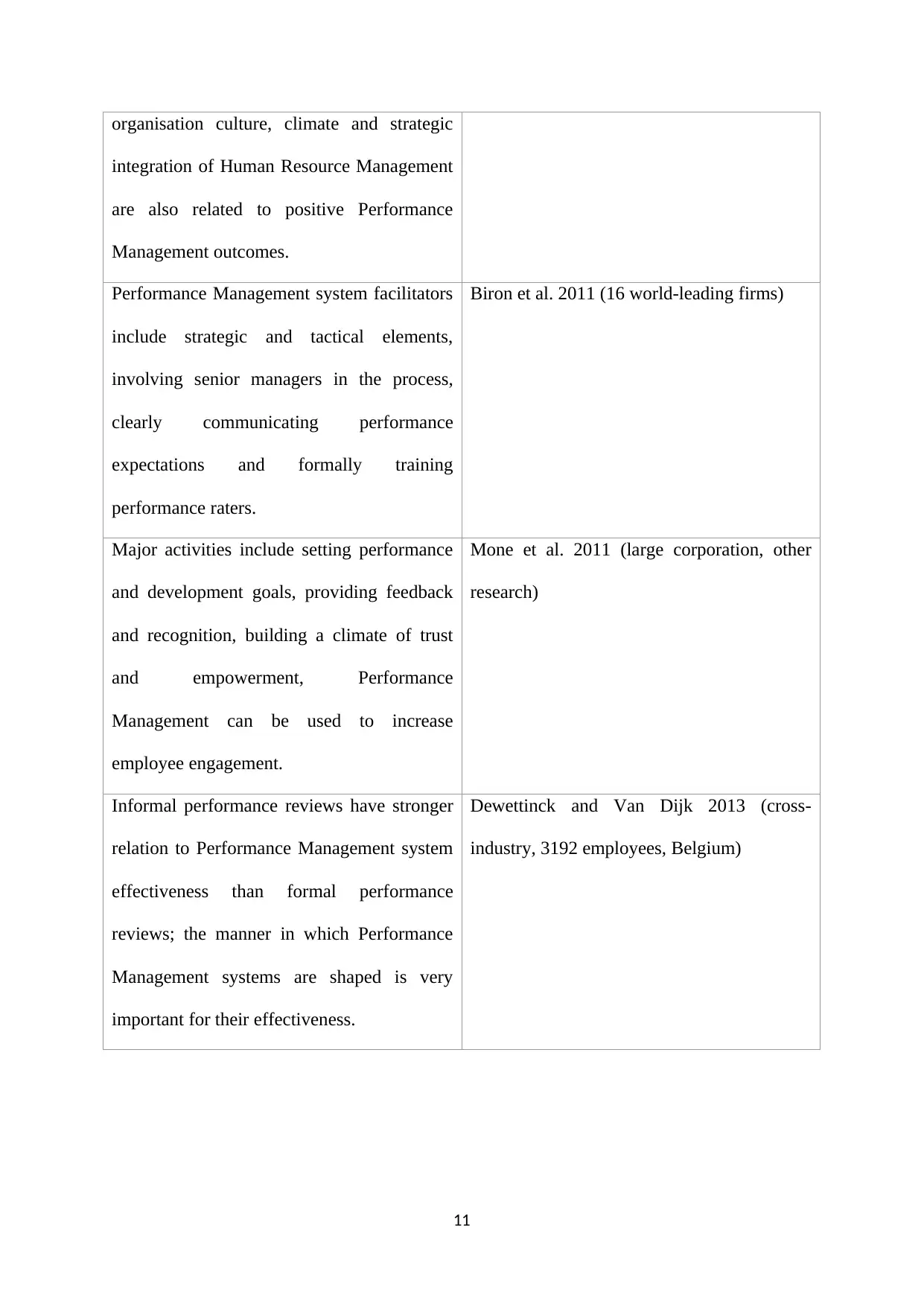
organisation culture, climate and strategic
integration of Human Resource Management
are also related to positive Performance
Management outcomes.
Performance Management system facilitators
include strategic and tactical elements,
involving senior managers in the process,
clearly communicating performance
expectations and formally training
performance raters.
Biron et al. 2011 (16 world-leading firms)
Major activities include setting performance
and development goals, providing feedback
and recognition, building a climate of trust
and empowerment, Performance
Management can be used to increase
employee engagement.
Mone et al. 2011 (large corporation, other
research)
Informal performance reviews have stronger
relation to Performance Management system
effectiveness than formal performance
reviews; the manner in which Performance
Management systems are shaped is very
important for their effectiveness.
Dewettinck and Van Dijk 2013 (cross-
industry, 3192 employees, Belgium)
11
integration of Human Resource Management
are also related to positive Performance
Management outcomes.
Performance Management system facilitators
include strategic and tactical elements,
involving senior managers in the process,
clearly communicating performance
expectations and formally training
performance raters.
Biron et al. 2011 (16 world-leading firms)
Major activities include setting performance
and development goals, providing feedback
and recognition, building a climate of trust
and empowerment, Performance
Management can be used to increase
employee engagement.
Mone et al. 2011 (large corporation, other
research)
Informal performance reviews have stronger
relation to Performance Management system
effectiveness than formal performance
reviews; the manner in which Performance
Management systems are shaped is very
important for their effectiveness.
Dewettinck and Van Dijk 2013 (cross-
industry, 3192 employees, Belgium)
11
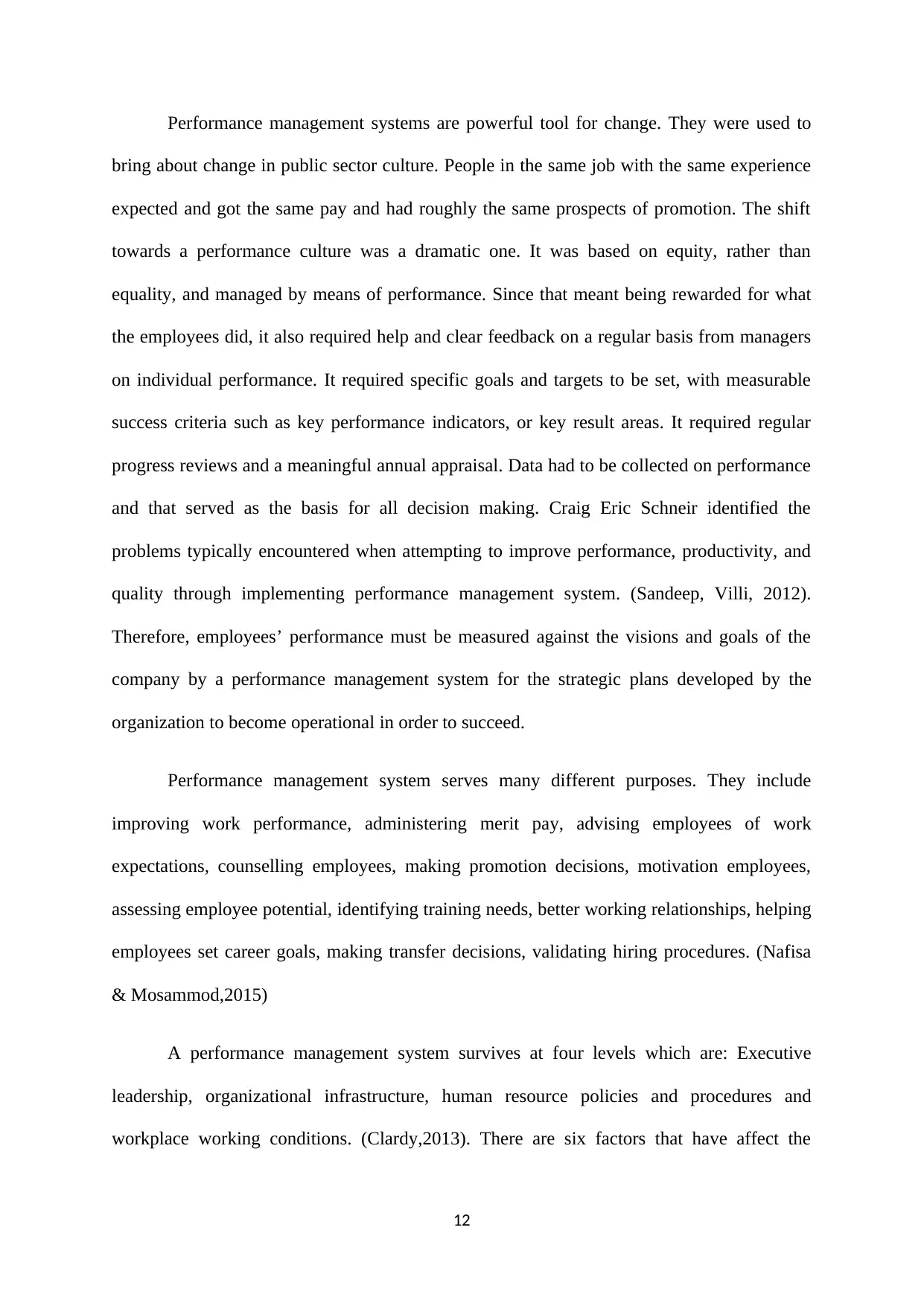
Performance management systems are powerful tool for change. They were used to
bring about change in public sector culture. People in the same job with the same experience
expected and got the same pay and had roughly the same prospects of promotion. The shift
towards a performance culture was a dramatic one. It was based on equity, rather than
equality, and managed by means of performance. Since that meant being rewarded for what
the employees did, it also required help and clear feedback on a regular basis from managers
on individual performance. It required specific goals and targets to be set, with measurable
success criteria such as key performance indicators, or key result areas. It required regular
progress reviews and a meaningful annual appraisal. Data had to be collected on performance
and that served as the basis for all decision making. Craig Eric Schneir identified the
problems typically encountered when attempting to improve performance, productivity, and
quality through implementing performance management system. (Sandeep, Villi, 2012).
Therefore, employees’ performance must be measured against the visions and goals of the
company by a performance management system for the strategic plans developed by the
organization to become operational in order to succeed.
Performance management system serves many different purposes. They include
improving work performance, administering merit pay, advising employees of work
expectations, counselling employees, making promotion decisions, motivation employees,
assessing employee potential, identifying training needs, better working relationships, helping
employees set career goals, making transfer decisions, validating hiring procedures. (Nafisa
& Mosammod,2015)
A performance management system survives at four levels which are: Executive
leadership, organizational infrastructure, human resource policies and procedures and
workplace working conditions. (Clardy,2013). There are six factors that have affect the
12
bring about change in public sector culture. People in the same job with the same experience
expected and got the same pay and had roughly the same prospects of promotion. The shift
towards a performance culture was a dramatic one. It was based on equity, rather than
equality, and managed by means of performance. Since that meant being rewarded for what
the employees did, it also required help and clear feedback on a regular basis from managers
on individual performance. It required specific goals and targets to be set, with measurable
success criteria such as key performance indicators, or key result areas. It required regular
progress reviews and a meaningful annual appraisal. Data had to be collected on performance
and that served as the basis for all decision making. Craig Eric Schneir identified the
problems typically encountered when attempting to improve performance, productivity, and
quality through implementing performance management system. (Sandeep, Villi, 2012).
Therefore, employees’ performance must be measured against the visions and goals of the
company by a performance management system for the strategic plans developed by the
organization to become operational in order to succeed.
Performance management system serves many different purposes. They include
improving work performance, administering merit pay, advising employees of work
expectations, counselling employees, making promotion decisions, motivation employees,
assessing employee potential, identifying training needs, better working relationships, helping
employees set career goals, making transfer decisions, validating hiring procedures. (Nafisa
& Mosammod,2015)
A performance management system survives at four levels which are: Executive
leadership, organizational infrastructure, human resource policies and procedures and
workplace working conditions. (Clardy,2013). There are six factors that have affect the
12
⊘ This is a preview!⊘
Do you want full access?
Subscribe today to unlock all pages.

Trusted by 1+ million students worldwide
1 out of 41
Related Documents
Your All-in-One AI-Powered Toolkit for Academic Success.
+13062052269
info@desklib.com
Available 24*7 on WhatsApp / Email
![[object Object]](/_next/static/media/star-bottom.7253800d.svg)
Unlock your academic potential
Copyright © 2020–2025 A2Z Services. All Rights Reserved. Developed and managed by ZUCOL.





